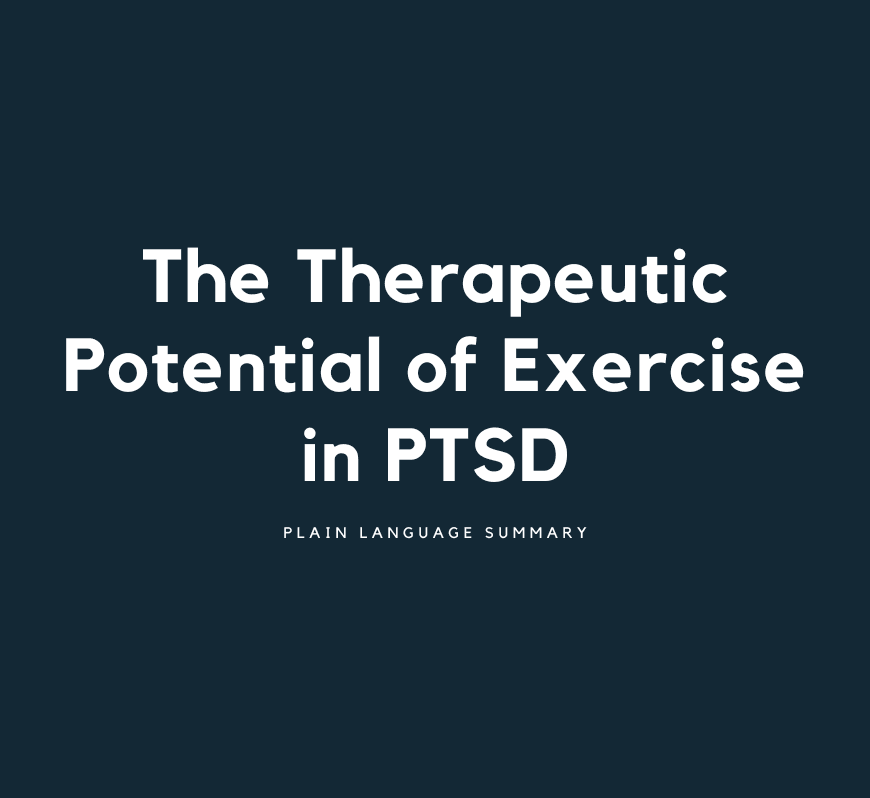Unravelling the mechanisms underlying the therapeutic potential of exercise in post-traumatic stress disorder (PTSD), a systematic review
We conducted a living systematic review and meta-analysis examining the effects of exercise on symptom severity and functional impairment in posttraumatic stress disorder (PTSD). We also looked at potential mechanisms of action of exercise, such as biological factors like brain derived neurotrophic factor (BDNF), psychosocial factors like cognitive appraisal (how one thinks about and appraises a situation), and emotional state, which may influence how exercise affects symptoms and functioning. PTSD is a mental health condition that is consequent to a traumatic event. Symptoms of PTSD include reliving the traumatic event, nightmares, increased vigilance, startling easily, and avoidance of things that may remind the person of the trauma.
View the full report on Wellcome Open Research.
Currently, there are effective, evidence-based psychotherapies such as Cognitive Behavioural Therapy (CBT) and Eye Movement Desensitisation and Reprocessing (EMDR), however these are not effective for everyone, and people with PTSD can relapse following treatment. In recent years, exercise has been added on to psychotherapy to enhance the benefits of psychotherapy and reducing the risk of relapse. Aerobic exercise (such as walking, swimming, running, and cycling) on its own has also been found to have positive effects on PTSD symptoms.
Exercise may work as an add-on treatment for PTSD by altering brain chemicals linked to stress reduction and mood regulation or by other mechanisms. Exercise can influence the levels of brain chemicals associated with stress reduction and mood regulation, such as BDNF, endocannabinoids, and mTOR. These chemicals help with growth, regeneration, and connectivity of brain cells, which may be helpful in PTSD treatment. By enhancing BDNF levels for example, exercise may help people with PTSD to permanently forget traumatic memories. Engaging in regular exercise can boost self-esteem and confidence, which are often diminished in individuals with PTSD.
Moreover, the sense of accomplishment and mastery gained through physical activity can foster positive feelings and a sense of control over one's life, even in the face of trauma. Lastly, exercise can serve as a healthy distraction from intrusive thoughts, flashbacks, and cognitive distortions characteristic of PTSD. By focusing on the physical sensations and challenges of exercise, individuals may temporarily escape or alleviate the intensity of their psychological symptoms. Thus, incorporating exercise into PTSD treatment plans, alongside other evidence-based interventions such as therapy and medication, can offer holistic support for individuals striving to manage their symptoms and improve their overall well-being.

This living systematic review was carried out to examine the existing evidence for exercise among individuals with PTSD. We reviewed human studies and also animal research using models of PTSD. For human studies, we identified 11870 records. The titles and abstracts of 7086 records were compared against the eligibility criteria and 161 of those were further examined as potentially eligible by assessing their full texts. From those, we found 11 eligible studies from which we extracted the data to summarise.
For the animal studies, we searched 8 databases for existing studies, the titles and abstracts of 1222 records were compared against the eligibility criteria, and 43 full texts were screened. We found 14 eligible studies from which we extracted the data to summarise.
Each of the 14 non-human studies, examined factors that might influence treatment outcomes for PTSD. Eight focused on BDNF, six on stress physiology, and nine on other changes in the brain and body. Of the 11 human studies, three looked at these factors. One examined how people felt about danger during certain memory tasks, BDNF and other chemicals in the body, another one examined BDNF level, and the third one focused on how people felt after during exercise.
Results from animal studies suggest that exercise could be helpful in treating PTSD. Results from human studies found improvement in functional impairment but not in reducing PTSD symptom severity, though high-intensity exercise appears more beneficial. Much as we do not have enough data to understand exactly how exercise helps with PTSD symptoms, exercise was found to increase BDNF levels, improve cognitive appraisal and perceived exertion which might in turn help reduce PTSD symptoms. These findings highlight the need for more high-quality research to determine if and how exercise can benefit people with PTSD around the world.

